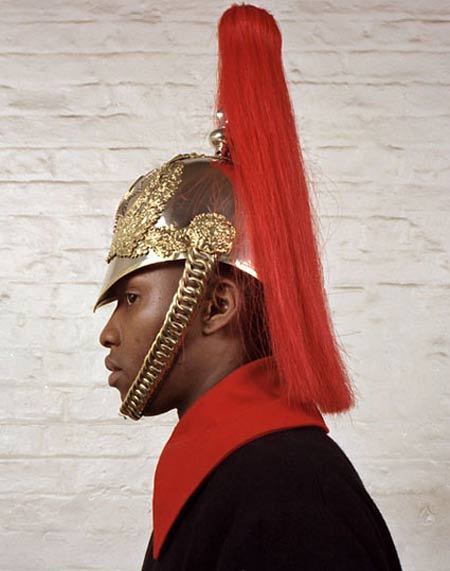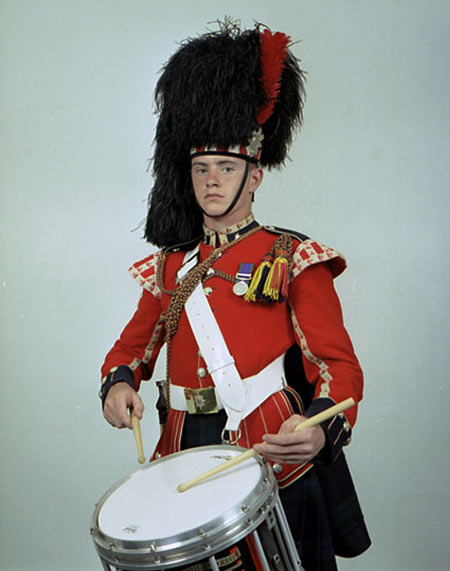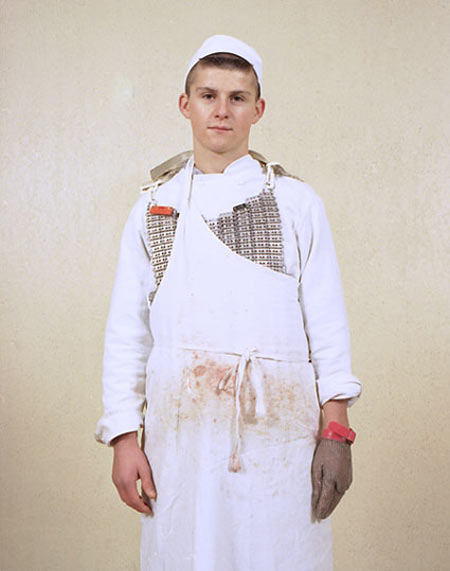A Conversation with Charles Fréger

Charles Fréger works in series of portraits and is the mastermind behind a pan-European network of photographers - which provided ample reasons for me to approach him and ask for an interview. He was more than happy to share his thoughts about photography and about how to work together as a group of artists.
Jörg Colberg: Your work could be described as typological portraiture. How did you arrive at working on such portraiture? And how much of an influence do artists such as the Bechers or Rineke Dijkstra have on your work?
Charles Fréger: I consider the work of some of the German students of the Bechers more like a typology than my own work. In fact, I consider it more like an accumulation of portraits. In a series, I can mix different types of portraits, close ups, full-body portraits, and so on - like I did with the Opera series or the Rikishi series (about the sumo wrestlers). “Legionnaires” and “Water Polo” are more typological than my other series, but still… I don’t expect to have the objectivity a Becher student would try to keep. It’s much more a process dealing with psychology. I’m impressed by the Becher’s work, and I take this as a reference for the way they kept going with this inflexible project.
The “beach” series by Rineke Dijkstra is beautiful. I think she managed to have a certain objective point of view, mixed with a deep empathy toward her models. That’s how I feel close to her work. From the outside, my work looks probably like a conceptual and serial project. But this led me very fast to something more sensible, full of hesitations. Hesitation is a real key in my work. I don’t accumulate all these portraits just to get an impact, but also because I’m interested in the hesitation of the person I photograph and, through that, also in my own hesitation.
I don’t believe in any kind of distance between a photographer and the subject. To decide to go somewhere to shoot these portraits, you at least have to feed a strong wish and some desire. I could be a sumo wrestler, you know!

JC: Given what you just said, it’s possible that some people might interpret your work in other ways, maybe for example seeing it as only typological and missing some of the other aspects. How do you deal with that as the artist, as the person whose intention might have been misunderstood? Does it bother you?
CF: Not at all. There’s some time for that. Not everything can be in the images… It’s a global project with exhibitions, books, texts, performances, video. I think that every artist has different layers in his work. There’s what you can see on the surface, and what you get to know progressively. I’m still young and have only spent ten years on this research of portraits and uniforms. I have also been discover what I’m doing progressively, especially this past year. Maybe photography as the sole medium doesn’t allow me to express everything I like to express. Maybe that’s why I did a performance this year (Vis. Voluntatis), which I really consider as a part of my photographic work. Being misunderstood is not a big problem compared with being ignored.

JC: How do you decide what “group” to pick for a new series? And how do approach working with a new group?
CF: I usually have an image in mind, something strong, like an excitation… I just want to go to get it. It’s like Captain Ahab and Moby Dick in the Melville book (it’s amazing what Gille Deleuze, the philosopher, wrote about that). I start to collect some information about the community I wish to photograph, and I try to get in touch with them. It can take a few months or some years (like with some of the royal regiments I photographed for the “Empire” series). There’s always a sort of negotiation, because, of course, I need to photograph more than one person, and I often need to spend some time with each group. It’s as if I was discussing the invasion of their territory. When I go somewhere to do a series I really take up some space with all my equipment, my flashlights and so on. Sometimes, there’s a team around me to assist and to translate. So, it’s never easy and flexible. I really get into the groups. It’s really a question of territory.
JC: You are the founding father of Piece of Cake (POC), a pan-European group or network of young photographers. Can you tell me a little bit about how you had the idea to start this group and how it has developed since its first inception?
CF: I think that my work is also about my feeling of being kind of an outsider. I’ve never been part of a real group. In 2002, when I was working in Finland, I decided to travel to Norway, up to the North. Imagine yourself alone in front of the dark sea, surrounded of snow… Very quickly, I came back to Helsinki (also thinking I was not really a good landscape photographer!!) with the idea that loneliness was a difficult question for photographers and artists in general. I felt that there’s kind of a gap after we get out of art school. Somehow, without a real network, it’s really difficult in Europe to get the right information, a real point of view about our work, a good exchange with other artists.
I created POC in June 2002 and invited 25 European photographers to take part of a meeting in my home town. Of course, it went very well, and we decided to keep going by creating a real network. We care about each other’s work, we support each other a lot, and most of us share the same galleries, agents… We share our doubts, and the commitment between us is important. When I was in Namibia last year, in the middle of nowhere with two flat tires on my car, the first thing I did was to write an SMS to one of the POC members… It did not fix the car, but still, it helped!

JC: Such communities don’t appear not to be that common - in our modern cut-throat art world it’s often one person fighting the other over the few opportunities to show work. Do you consider POC as a way to tell other photographers “Look, this is what you can gain from working
together!”?
CF: Somehow, we work together, by sharing our doubts, our experiences, our knowledge and our network. But we are not like an art group. We hardly work together on a common art project. And this still needs to be improved in our system. Not everything is that balanced and equal in POC. We are challenging each other quite a lot. Some get great exhibitions at the best festivals, others don’t… Some sell more photos than the others, and so on. But all in all, when something good happens for one of the members, every member get something out of it. Being a member of POC is like being labeled. That’s what we really get from our network at the moment. We have not reached the utopist point of POC, yet. We know what it should be… and we are still working on it, together, somehow.
CF: And what opportunities has POC brought for its members? Has the network lived up to its original ideas? To what size do you think would you want to expand the group?
CF: Every year, we have a meeting in some European town. The last meeting was in Antwerp, Belgium. The next will be in Budapest, Hungary. These workshops are really fundamental to keep the spirit up. It’s like in a family, we always need to feed the commitment. And we have some new members every year. We have to meet them. Well, of course, like every network it has its ups and downs. A few years ago, we had a visit by a specialist of the European Union during our workshop in Köln [Cologne]. He stayed with us to watch how POC was going and wrote a report about it. We found that POC was evolving in the same way as the European Union, with the same kinds of problems, the same expectations.
At the moment, we are 25. A board of 10 members votes (normally, it’s 1/3 of the members) for new candidates. We have a voting system online. It works pretty well actually.
We won’t go over 30 members, it would just be too much and we would lose this family aspect that I find very important.

JC: Given you have a lot of contact with many European colleagues, do you think that there are different kinds of aesthetics in different countries? A German look, a French look, …? And given we’re talking about countries, if you compare the European photography scene with the one in the US, what differences do you perceive?
CF: I presume there are some differences in Europe… Of course, you have schools in each country that are pushing the work of some teachers. Being a Becher student, or a Thomas Ruff student in Germany for sure will lead you to a certain objective photography. The Swiss schools also have their particularities, the same goes for the Arles school in France, I think… And the rest is about the sensibility of each photographer. But, for example, if you look at the work of Petros Efstathiadis, our new Greek member, you find that he is influenced by American photography, and at the same time his Greek background makes his work very particular.
Right now, I find the European scene still too fascinated by the American one. We all watch American movies, and we like the idea of photographing a gas station (but I think that without Marcel Duchamp and the concept of the “ready-made” Warhol would probably not have made his Brillo boxes)… I think too many photography students produce images with an American influence without analyzing why. But I see this changing. And there are a lot of exchanges between the two scenes… and that’s really important.
All in all, I find American photography to be more narrative than the European one. From the beginning, the “function” of photography in the US has been really different. The US needed photography and cinema to create its history. That’s why it looks so essential there. In Europe, I think, it’s seen as a medium like the others.

JC: Would it be an option then to invite photographers from the US or from Japan or China to join POC? Or will POC remain European? And maybe there are or will be other ways to cooperate with photographers living outside of Europe?
CF: We’ve tried already. In fact, some photographers from Canada, the US and Japan asked to take part of POC. But the point is to be able to meet once a year. And this would be more difficult. And we are not strong enough at the moment to open POC. At the moment, we keep working on the European aspect first. The discussions we have in POC are quite oriented towards the European market, too. We once suggested to a Japanese photographer to create a Japanese or an Asian POC network. But you need some energy to build something like that. But in the future, we’ll invite non-European photographers to take part in our workshops, if they wish to organize something similar.
 By
By